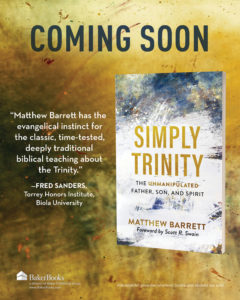
What the New Testament Hymns Teach us about Early Christian Worship
 A concern of many church leaders is the extent to which Christian worship today reflects the practices, values, and significance of worship in the earliest Christian assemblies. With nearly two millennia separating us from the first followers of Jesus, and living our lives in vastly differently cultural and social settings, it can be hard to assess where our worship practices are in line, or out of line, with how the earliest believers worshipped. Our resources for doing so are limited since descriptions of early Christian worship and primary sources about Christian practices are generally a century or more removed from the very first Christian assemblies.
A concern of many church leaders is the extent to which Christian worship today reflects the practices, values, and significance of worship in the earliest Christian assemblies. With nearly two millennia separating us from the first followers of Jesus, and living our lives in vastly differently cultural and social settings, it can be hard to assess where our worship practices are in line, or out of line, with how the earliest believers worshipped. Our resources for doing so are limited since descriptions of early Christian worship and primary sources about Christian practices are generally a century or more removed from the very first Christian assemblies.
While such resources do provide important insights, they also reflect the cultures and practices that developed in later centuries as the message about Jesus was embraced by new communities with their own understanding of what worship should entail. The New Testament is our only direct source from the first century and it provides a little by way of describing Christian worship with particular mention of prayer, “psalms, hymns and spiritual songs” (Col. 3:16), the practice of baptism, the Lord’s supper, and the sharing of prophecy in the gatherings of believers. But these biblical references are generally specific to one particular context or letter, and have lead to many differing interpretations of the extent to which they are descriptive of what was happening in one community or prescriptive for all believers everywhere.
The early Christians understood that one true God was fulfilling the ancient promises of renewal through Jesus and they celebrated this reality through hymns of praise. Share on XOne under-utilized source we have for understanding the nature of early Christian worship are the words of the earliest Christian hymns some of which, as it turns out, are preserved for us in the pages of the New Testament. For about the last century, biblical scholars have used tools of literary analysis to identify passages throughout the New Testament which reflect the features of ancient hymnody and psalmody. Their research has revealed a wide range of passages from the gospels to the epistles to Revelation which reflect the kinds of hymns used in worship by the believers in the first century.
In some cases, these are highly poetic passages which may have been hymns in their own right. These include passages like Phil 2:5-11, Col 1:15-20, and John 1:1-18 which many commentaries now identify as christological hymns and which are readily observed to be poetic in their construction. In other cases we find phrases or passages which may have been excerpts from longer hymns, such as Eph 2:14-16 and 1 Tim 3:16. In still other cases, we have language in the New Testament which may not be from actual hymns, but is so formally styled that it likely reflects the kinds of language that was being used in worship (e.g., Heb 1:1-3; 1 Pet 3:18-22). The songs of praise recorded in Luke 1-2 and the praises of God and the Lamb in Rev 4-5 likely also reflect the ways in which Christ was praised within the early Christian assemblies.
What do these hymns and hymn-like passages tell us about early Christian worship? We can approach this question in two ways: what we learn from the content of the hymns, and what we learn from the context of the hymns. These angles help us understand the power of hymns in early Christian worship.
The Content of Early Christian Hymns
When we survey the content of the New Testament christological hymns, we find a wide variety in terms of style, focus, and presentation, but also a number of common themes across these passages. A major focal point is Jesus Christ, and especially his life, death, resurrection, and exaltation. In this respect we can say that early Christian worship was centered on the story of Jesus. The cross is a particular point of emphasis which, rather than downplayed for its shameful associations, is celebrated as a central aspect of the message about Jesus. Another focal point is an emphasis on the saving work of Jesus toward humanity including his work of redemption, reconciliation, and making peace.
These themes draw deeply on Jewish theological concepts including the announcement of eschatological renewal through God’s agent, demonstrating early Christian reflection on passages like Isaiah 40-66. The connections with first-century Judaism are so strong that it is fair to say that early Christian worship cannot be fully appreciated apart from its Jewish context. The early Christians understood that one true God was fulfilling the ancient promises of renewal through Jesus and they celebrated this reality through hymns of praise. The hymns not only proclaim truths about Jesus—they also invite the worship participant into an experience of a spiritual reality that is not necessarily visible in the world around them. Share on X
In addition, if we look at the wider landscape of Greek and Roman hymns we observe that the offering of praises to a particular god in ancient times included such things as the origin of the deity, the names of the deity, and the accomplishments of the deity that have benefited humanity. These kinds of elements are present in the early Christian hymns as well, indicating a close connection with the cultural setting of the first century. From the content of the early Christian hymns we can see that they are focused on Jesus and are critically engaged with ideas and values from their cultural context. It is also easy to recognize that these passages would be at home in settings of worship, public confession of faith, and baptism, as well as in ethical instruction and apologetics. Given their rich content, it makes sense that the New Testament writers would draw on these hymns as resources for their own letters and other writings.
The Context of Early Christian Hymns
Aside from what the hymns actually say, we can also draw some important conclusions from their presence within the New Testament. First, they provide clear evidence that hymnic praise of Christ was a feature of the first-century Christian gatherings from very early on. If hymns in praise of Jesus could be cited and included in the earliest New Testament writings, then they certainly pre-dated those writings.
Second, the presence of this praise language in writings as varied in origin as the gospels, the letters of Paul, and Revelation shows that such praise of Jesus through hymns was widespread and not limited to one particular strand of the early Christian movement.
Third, hymnic praise of Jesus shows that Jesus was being closely associated with the divine. Who else had hymns written in their honor? In the Jewish tradition, of course, the one true God. In Greco-Roman traditions the gods were honored by hymns. Notably, however, the Roman emperor was also a recipient of hymnic praise as one who was considered to be the offspring of the gods, the savior of humanity, and whose birth was “good news.” So aside from the claims that the hymns make about Jesus, the very fact that hymns were composed in honor of him is itself an attestation of the remarkable status that was being ascribed to him by his early followers.
The Power of Early Christian Hymns
Hymns like this would have the power to shape their thoughts, engage their emotions, and invite followers of Jesus to see themselves as living out their lives in a world which was in the process of being reconciled by its creator. Share on X The early Christian hymns from within the New Testament also reveal one more important characteristic of early Christian worship: its affective dimension. Because of their poetic and stylistic features, the hymns we encounter in the New Testament cannot simply be understood as doctrinal statements created for cognitive assent. Rather, their rich poetic language, metaphors, and elevated style were well-suited to engage the emotions and hearts of those who would hear them or recite them. The hymns not only proclaim truths about Jesus—they also invite the worship participant into an experience of a spiritual reality that is not necessarily visible in the world around them.
To take one example, this can be seen particularly well with the Philippians hymn (Phil 2:5-11) which at its climax describes every knee in heaven, on earth and under the earth bowing, and every tongue confessing that Jesus Christ is lord. As the early Christians declared this to be ultimate reality, they were using their imaginations to envision it, as it was certainly not visible in their earthly lives in which the reign of the divine Roman Emperor was absolute. They were declaring it to be reality. And in addition to engaging their imaginations, they were also actively participating in that very scene of universal worship as they themselves were bowing and declaring “Jesus Christ is Lord.”
In such an example we can see that the content of the hymn, the context of the hymn, and the performance of the hymn would have been very powerful indeed. Hymns like this would have the power to shape their thoughts, engage their emotions, and invite followers of Jesus to see themselves as living out their lives in a world which, no matter what they saw around them, was in the process of being reconciled by its creator and redeemer.

